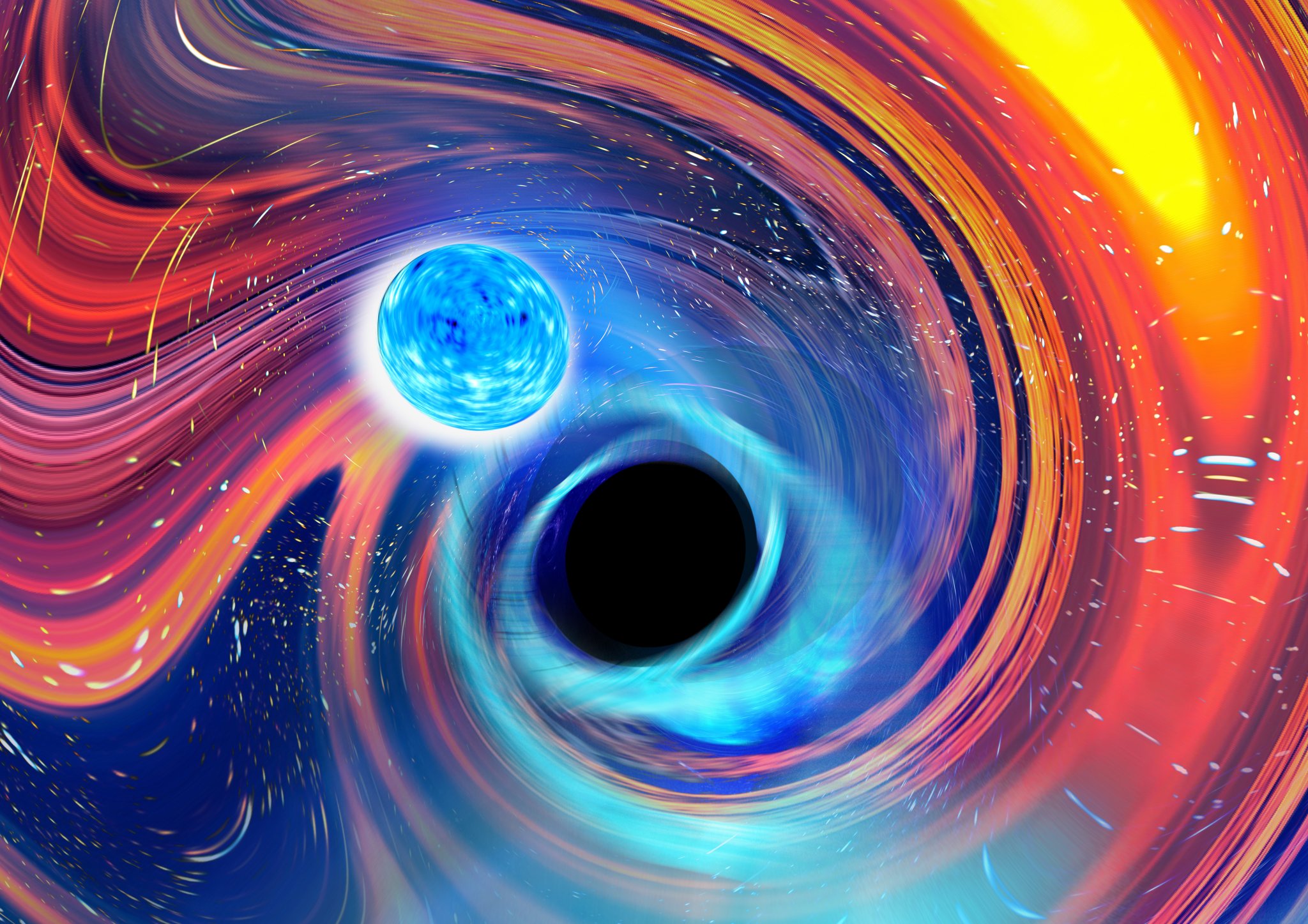

A collaboration of astrophysical wizards has spent the last six years listening for sub-microscopic tremors in the fabric of space rippling through our planet. Their now-intercontinental network has picked up the reverberations of black holes colliding with black holes and even neutron stars crashing into neutron stars.
Now, for the first time, they have clearly sensed the merging of neutron stars with black holes, wrapping up their three-item gravitational wave punch card and earning them one free glimpse into the afterlives of dead stars.
“Today we’re announcing the discovery of a black hole merging with a neutron star,” wrote Daniel Williams, an astrophysicist at the University of Glasgow and member of the team behind the find, on Twitter. “We have completed the set.”
When huge stars at least a dozen times more massive than the sun die, they generally suffer one of two fates: If, in its death throes, a star packs enough matter into a certain volume, it ceases to be matter as we know it and collapses into a black hole. Or if the demise isn’t quite so intense, the atoms in the star’s core get squished into a ball of mostly neutrons known as a neutron star.
Almost nine out of ten stars are born with, and live with, at least one partner star. As the couples grow old and die, astrophysicists have long supposed, they’ll transition to an existence as two black holes, two neutron stars, or one of each.
One of the main motivations for building the Laser Interferometer Gravitational-Wave Observatory (LIGO) was to look for the gravitational waves that physicists predicted would ripple out into the universe as these titanic objects spiraled toward each other and merged. LIGO detected the first black hole merger in 2015 and the first neutron star merger in 2017. But whether the universe definitely paired black holes with neutron stars remained up for debate.
[Related: Something sent one of the universe’s heaviest black holes flying]
“There’s just been so much uncertainty surrounding if they exist, how they could form, and how abundant they are in our universe,” says Ryan Magee, an astrophysicist at the California Institute of Technology and LIGO member.
Now the researchers have two good reasons to believe that the odd couples do exist.
Magee was driving on January 5, 2020, when the first alert came in. It didn’t seem like a big deal at the time, because the wave had only registered in one of the network’s three detectors (LIGO’s two facilities collaborate with the Virgo interferometer in Italy), and the signal wasn’t particularly crisp.
But just 10 days later, a similar gravitational wave rattled all three detectors at once. The LIGO/Virgo collaboration raced to study the detection. “I remember attending a lot of calls very fast,” Magee says.
Analyzing gravitational waves is a bit like hearing a crash outside your window, and, without looking, guessing what caused it. A high-pitched clatter might indicate two bikers crossing paths, while a lower rumble could indicate a collision between heftier vehicles. Astrophysicists look at the wave they’ve recorded and try to estimate the masses of the objects involved, all without witnessing the event directly.
Here’s what they think happened in January of 2020. Both collisions seem to have involved a heavy body and light body. The heavier partners may have weighed about nine and six solar masses, respectively (the lightest black holes are thought to weigh around five solar masses). And the collaboration estimates that the lighter partners weighed 1.9 times and 1.5 times the mass of the sun. That puts both of them comfortably below the theoretical 2.5 solar mass upper limit for the heftiest neutron stars. The collaboration detailed their results on Tuesday in The Astrophysical Journal Letters. Black hole-neutron star merger detection: achieved.
In each case, the lighter neutron star likely spiraled toward its companion black hole and plunged in, like a billiard ball disappearing into a corner pocket. Because the black holes seem so much heavier than the neutron stars, they likely swallowed the incoming objects whole—a disappointment to astronomers.
“Ideally, we’d like to see the neutron be torn apart and disrupted by the black hole because this would fling matter all around the black hole and give us a chance at seeing it with telescopes,” Magee said, “but unfortunately I don’t think anything like that happened this time.”
From such a fireworks show, researchers could have gleaned clues about the speed at which gravity’s influence travels through space, how fast the universe is expanding, and hints as to the poorly understood nature of matter in neutron stars.
[Related: Why are big neutron stars like Tootsie Pops?]
Nevertheless, Magee finds the discovery encouraging. Based on these collisions, the collaboration estimates that a black hole gulps down a neutron star roughly once per month, somewhere within a billion light years of Earth, so astronomers should have more chances to catch a glimpse of the aftermath.
Until then, LIGO and Virgo will listen for more rumbles, and start to build a statistical picture of black hole-neutron star pairings that will help astrophysicists work out if the objects tend to be born together as stars, or whether bustling galaxies or star clusters might bring them together after death.
And while LIGO’s punch card is now complete, Magee still hopes for a couple of bonus items. In addition to a neutron star-black hole collision with a violent, visible outburst, he’s also on the lookout for a cosmic rumble from a crash involving one party even lighter than our sun.
Textbook theories don’t predict such pipsqueak objects, so their existence would be evidence of some novel phenomenon, such as black holes formed from collapsing clouds of dark matter, or from extremely dense spots created during the Big Bang.
“It’s indicative of new physics,” he says. “You’d have to figure out exactly what led to it.”
